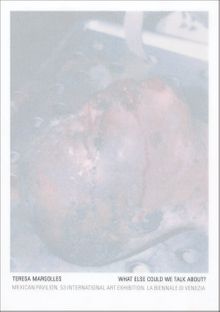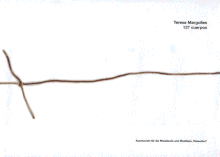ARTIST MONOGRAPHS
|
|
STATUS: Out of stock Temporarily out of stock pending additional inventory. |
 Teresa Margolles: Frontera
Teresa Margolles: Frontera
Published by Walther König, Köln.
Text by Alpha Escobedo, Leobardo Alvarado, Rein Wolfs, Letizia Ragaglia.
PUBLISHER
Walther König, Köln
BOOK FORMAT
Clth, 6.75 x 9 in. / 144 pgs / 70 color.
PUBLISHING STATUS
Pub Date 2/29/2012
Out of print
DISTRIBUTION
D.A.P. Exclusive
Catalog: SPRING 2012 p. 110
PRODUCT DETAILS
ISBN 9783865609762 TRADE
List Price: $54.95 CAD $72.50
AVAILABILITY
Not available
STATUS: Out of print | 00/00/00 For assistance locating a copy, please see our list of recommended out of print specialists |
 Teresa Margolles: What Else Could We Talk About?
Teresa Margolles: What Else Could We Talk About?
Published by RM.
Edited by Cuauhtémoc Medina. Text by Taiyana Pimentel, Elmer Mendoza, Ernesto Diazmartínez, Teresa Margolles, Antonio Escohotado, Mariana Botey.
PUBLISHER
RM
BOOK FORMAT
Hardcover, 9.25 x 6.5 in. / 160 pgs / 48 color.
PUBLISHING STATUS
Pub Date 3/31/2010
Out of print
DISTRIBUTION
D.A.P. Exclusive
Catalog: SPRING 2010 p. 143
PRODUCT DETAILS
ISBN 9788492480661 TRADE
List Price: $35.00 CAD $47.50
AVAILABILITY
Not available
STATUS: Out of print | 00/00/00 For assistance locating a copy, please see our list of recommended out of print specialists |
 Teresa Margolles: 127 Cuerpos
Teresa Margolles: 127 Cuerpos
Published by Walther König, Köln.
Text by Heriberto Yepez, Nike Bätzner, Patrizia Dander.
PUBLISHER
Walther König, Köln
BOOK FORMAT
Hardcover, 9.25 x 6.5 in. / 215 pgs / 165 color.
PUBLISHING STATUS
Pub Date 3/1/2007
Out of print
DISTRIBUTION
D.A.P. Exclusive
Catalog: SPRING 2007 p. 160
PRODUCT DETAILS
ISBN 9783925974663 TRADE
List Price: $61.00 CAD $82.50
AVAILABILITY
Not available
STATUS: Out of print | 00/00/00 For assistance locating a copy, please see our list of recommended out of print specialists |
 Teresa Margolles
Teresa Margolles
Published by Hatje Cantz.
Essays by Santiago Sierra, Udo Kittelmann, Elmer Mendoza and Gabriela Jauregui.
PUBLISHER
Hatje Cantz
BOOK FORMAT
Hardcover, 6.5 x 9.5 in. / 256 pgs / 40 color / 10 bw.
PUBLISHING STATUS
Pub Date 8/2/2004
Out of print
DISTRIBUTION
D.A.P. Exclusive
Catalog: FALL 2004
PRODUCT DETAILS
ISBN 9783775714730 TRADE
List Price: $35.00 CAD $40.00
AVAILABILITY
Not available
STATUS: Out of print | 11/28/2010 For assistance locating a copy, please see our list of recommended out of print specialists |

